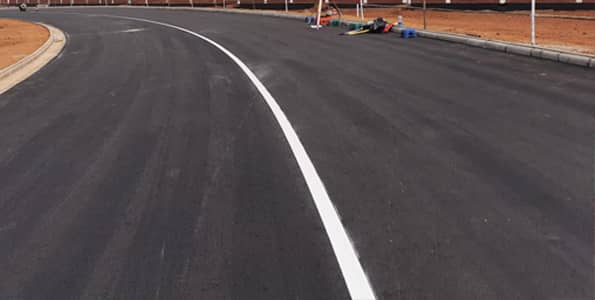Road Marking
What is Road Marking?
Road marking, often known as line marking, is the process of applying paints or other materials on concrete, asphalt, or pavements to convey information to drivers and pedestrians.
Reason to choose Road marking
Road marking is used globally as a means of delivering non-verbal communication, messages, and directions. The most prominent uses of road marking are to inform pedestrians and motorists of road rules, hazards, or no-passing zones, along with parking and stopping rules.


Advantages and Benefits of Road Marking
- Road markings help regulate traffic
- Ensures disciplined and safe driving
- Driver and pedestrian safety increases
- Serves as a psychological barrier and serves to indicate the traffic path’s demarcation.
- Roadways are marked with white and yellow lines to help keep cars on the right side of the road.
- Night-time visibility improves
- Parking space allocation and navigation are more efficient
- A dedicated lane for the cycle bay
Area of Usage or Scopes
Road marking is used on all the local and highway roads of a country. It is frequently used in parking places, cycle lanes, Safety zones, etc. It is also used on the roads of public and private factories, garments, industries, etc. You can also find it on the roads of public places, parks, hospitals, educational institutes, etc. Economic zones, power plants, and manufacturing units also have a demand for road and pavement markings. Pavement markings are an inevitable part of runways and taxiways.


Application Process
- Locating points on the roadway for the centerline and edge line markings by the engineer’s or consultants’ instructions.
- Wire-bristled scrubbing is used to remove dust from the road surface.
- Using an air compressor to blow away the surface-removed dust.
- Using a string and chalk approach, mark the centerline, the edge line, and the kurb line beforehand.
- Thermoplastic material is heated in an oil-jacketed pre-heater equipped with a hydraulic stirring system concurrently with the aforementioned operations.
- The pre-heater heats the thermoplastic material to a temperature of 180°C. An electronic temperature meter is used to measure the temperature.
- Hand-Push Machine or Fully Automated Machine will be employed on the Project
- The center lines, pedestrian crossing, etc. would be marked by a hand-push machine or Fully Automatic Machine because of the traffic flow on the 10 m Road.
- The thermoplastic road marking machine receives the molten thermoplastic material from the pre-heater.
- The applicator machine maintains the material’s temperature.
- The material is screeded out from the machine through the heated shoe at a thickness of 3 mm.
- Drop-on glass beads at a quantity of 300 gm/m² are dispensed on the surface of this screeded thermoplastic marking.
- Glass beads are dispensed regardless of speed thanks to a chain drive system.
- The highway with marking completed is allowed for traffic after a sufficient drying time of application and correct setting of thermoplastic material.
- When a machine cannot be utilized to complete the application, approved manual techniques must be employed, such as for arrows, etc.
Materials used in road marking
There are two types of road and line markings
Thermoplastic material
Thermoplastic is a durable road marking substance that was initially used in the United States in 1958 and soon spread to several nations in Europe. Glass beads, a binder, color, and filler make up the combination. Thermoplastic is related to heat, as its name indicates. The dry thermoplastic compound is generally heated in a thermostatically controlled pre-heater/boiler to a temperature of 170-210oC and agitated continuously until a homogenized liquid is achieved, before transferring to an applied vehicle. When thermoplastic is applied at this temperature, it melts into the asphalt’s top surface and creates a thermal connection. A tack coat primer should be used when applied to a concrete surface.
Waterborne materials
Like other paints, waterborne traffic marking paint is a thin coating of a mixed substance that may be applied to various surfaces. Its price is by far its biggest benefit over other traffic marking paints. It is one of the most affordable traffic marking materials available.


Types of road marking
There are a few types of road marking
- Thermoplastic road marking
- Curbstone marking
- Cycle lane
- Runway marking
- Traffic sign
Duration/ Life span
Road markings will serve 1-2 years depending on the surface of the road, traffic behavior, construction method, environmental condition, and product quality.


Authorized Distributor
We are the authorized distributor of Berger Paints ltd. and Berger Fosroc ltd.
Contact information
Contact for road marking works
Asst. Manager (Business Development)
Phone: +880 1313363885
Mail: mahmud.franklin@gmail.com

